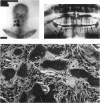Abstract
The syndrome of hereditary hyperparathyroidism and jaw tumors (HPT-JT) is characterized by inheritance, in an autosomal dominant pattern, of recurrent parathyroid adenomas, fibro-osseous tumors of the mandible and/or maxilla, Wilms tumor, and parathyroid carcinoma. This syndrome is clinically and genetically distinct from other endocrine neoplasia syndromes and appears to result from mutation of an endocrine tumor gene designated “HRPT2.” We studied five HPT-JT families (59 persons, 20 affected); using PCR-based markers, we instituted a genomewide linkage search after excluding several candidate genes. Lod scores were calculated at various recombination fractions (θ), penetrance 90%. We mapped HRPT2 to the long arm of chromosome 1 (1q21-q31). The maximal lod score was 6.10 at θ = .0 with marker D1S212, or >106 odds in favor of linkage. In six hereditary Wilms tumor families (96 persons, 29 affected), we found no linkage to 1q markers closely linked with HRPT2 (lod scores −15.6 [D1S191] and −17.8 [D1S196], θ = .001). Nine parathyroid adenomas and one Wilms tumor from nine members of three HPT-JT families were examined for loss of heterozygosity at linked loci. The parathyroid adenomas and Wilms tumor showed no loss of heterozygosity for these DNA markers. Our data establish that HRPT2, an endocrine tumor gene on the long arm of chromosome 1, is responsible for the HPT-JT syndrome but not for the classical hereditary Wilms tumor syndrome.
Full text
PDF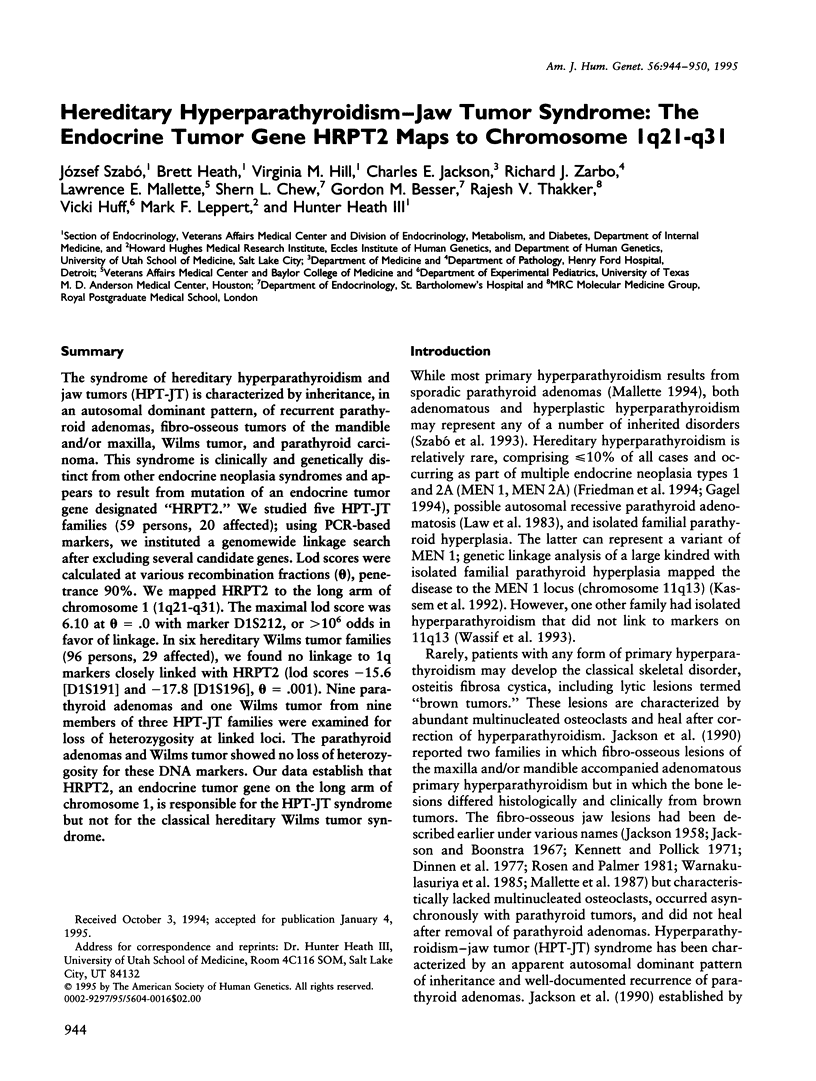
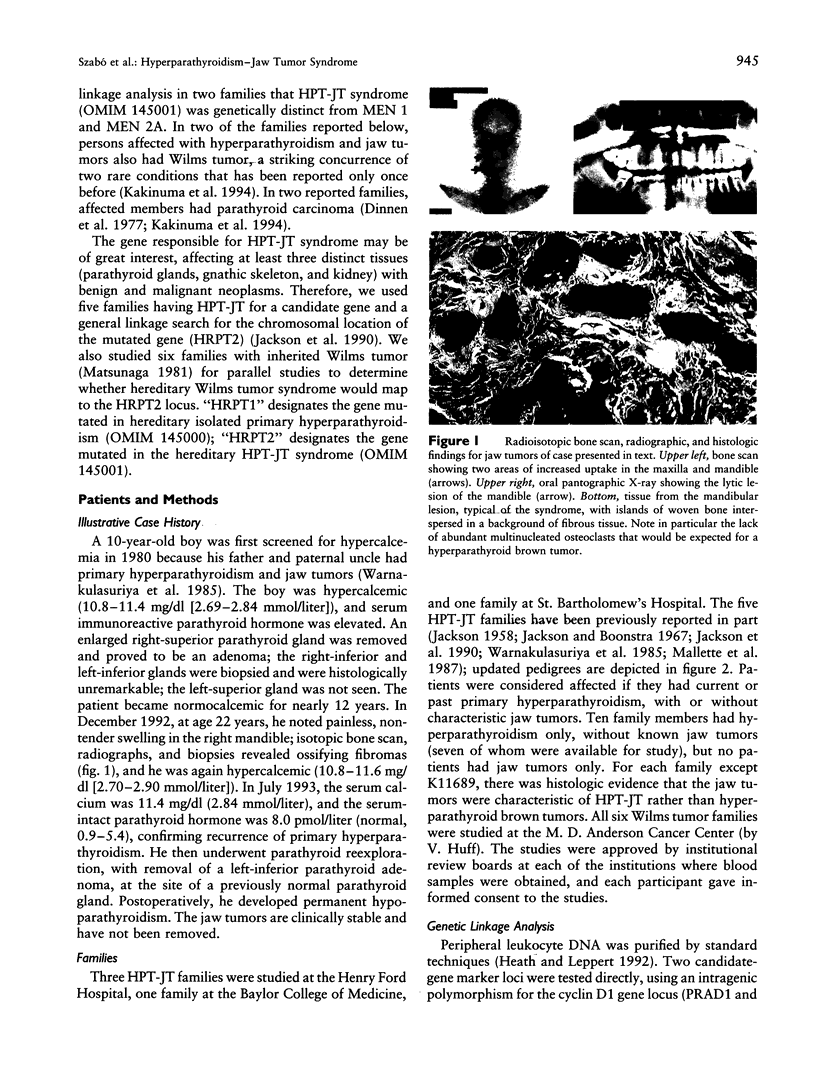
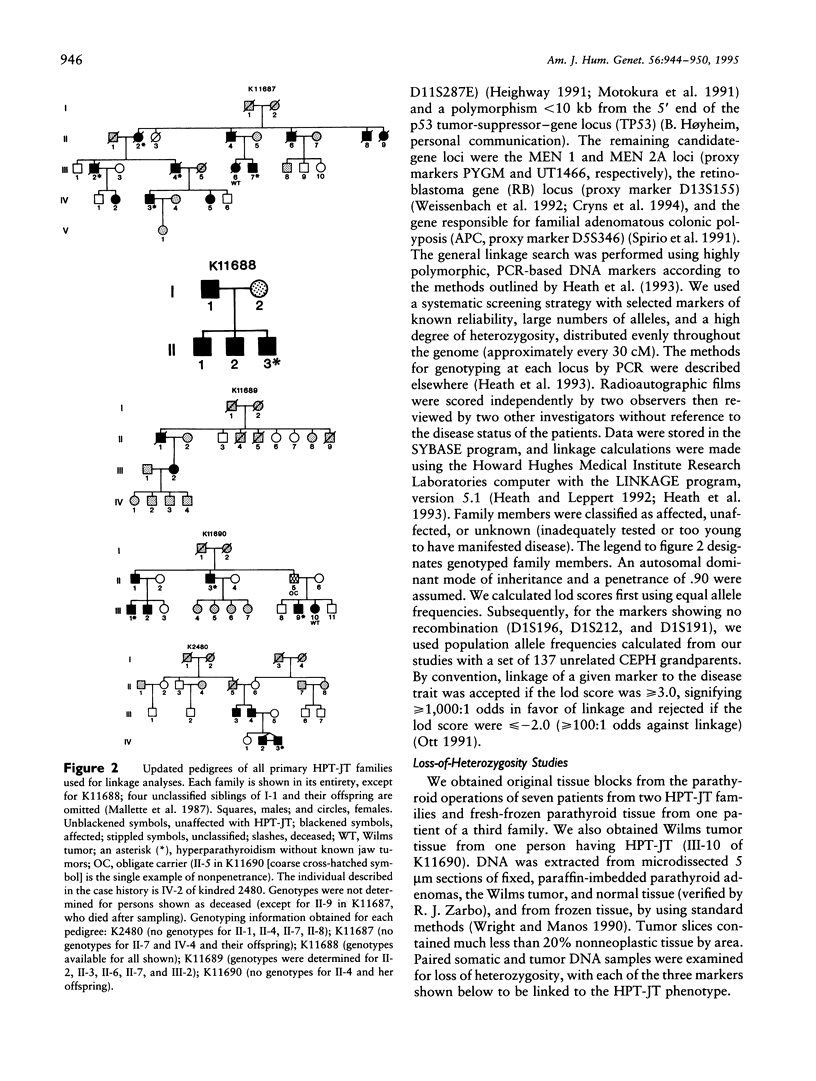
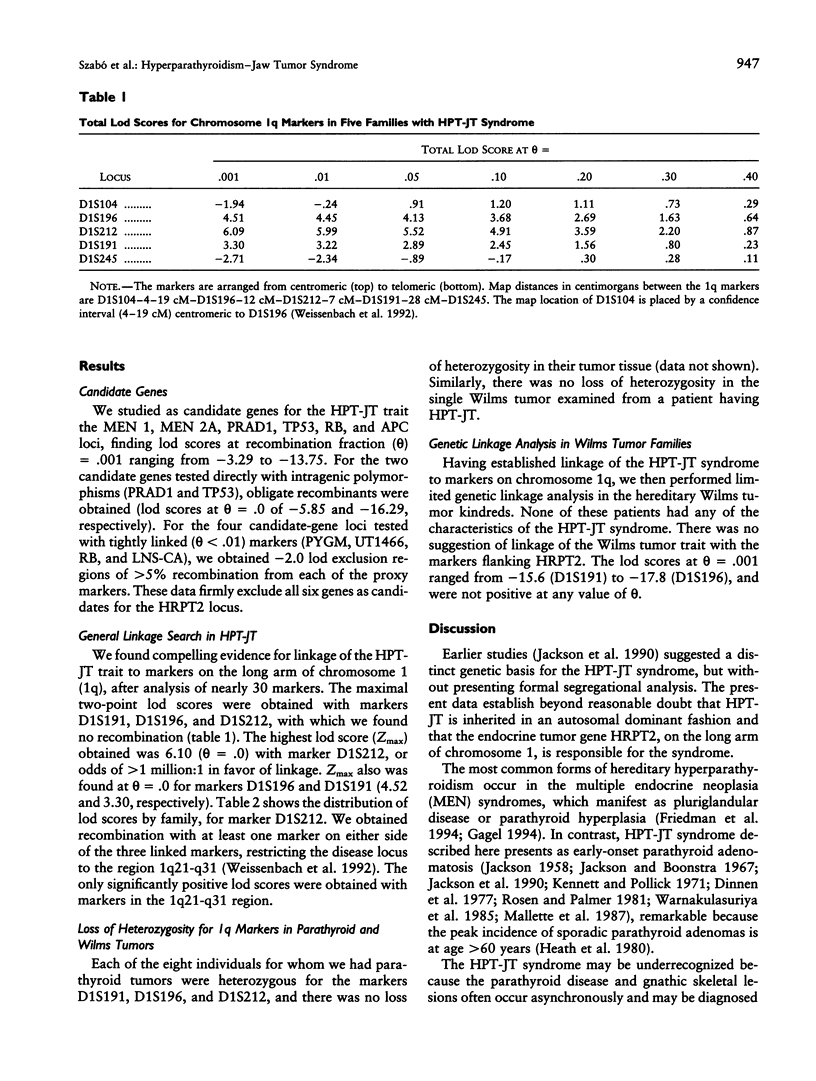
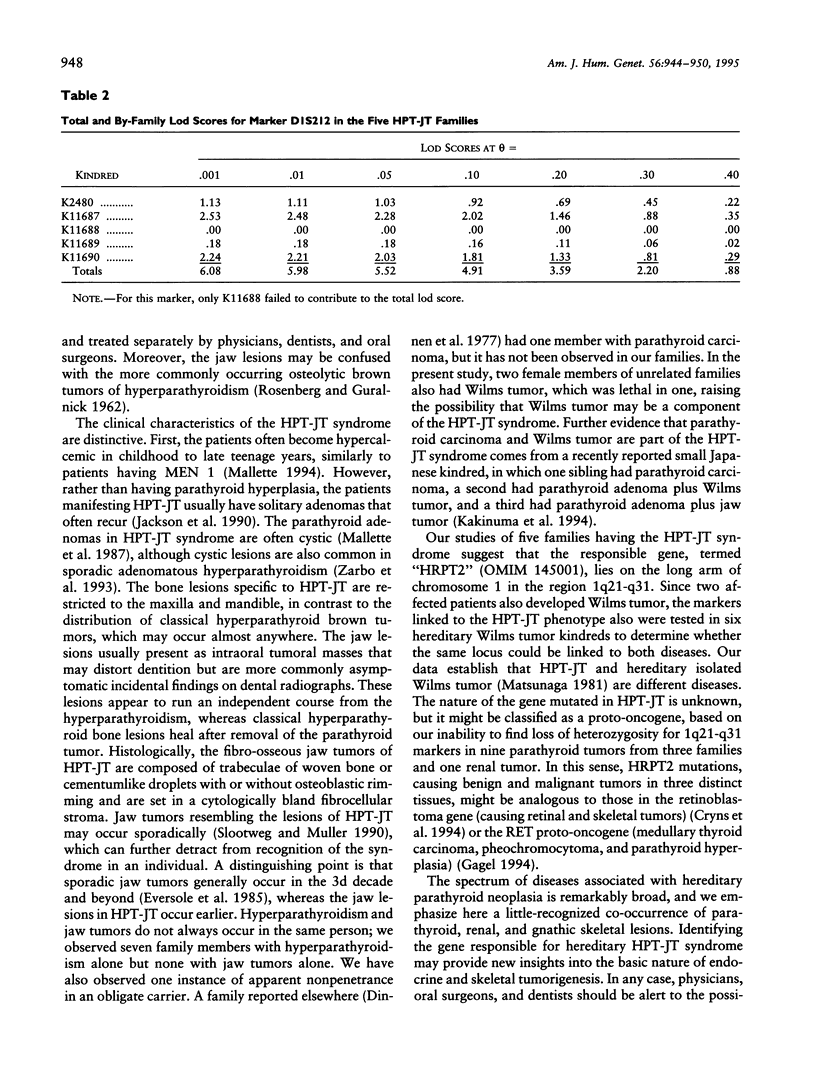
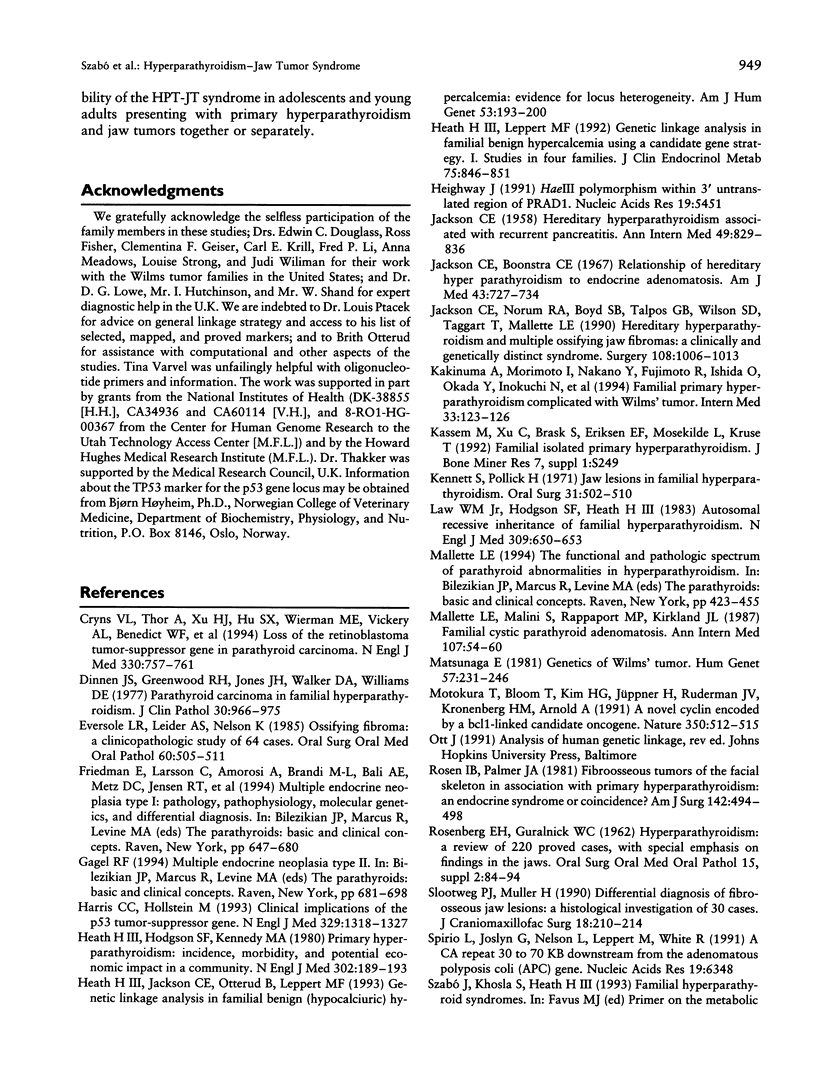

Images in this article
Selected References
These references are in PubMed. This may not be the complete list of references from this article.
- Cryns V. L., Thor A., Xu H. J., Hu S. X., Wierman M. E., Vickery A. L., Jr, Benedict W. F., Arnold A. Loss of the retinoblastoma tumor-suppressor gene in parathyroid carcinoma. N Engl J Med. 1994 Mar 17;330(11):757–761. doi: 10.1056/NEJM199403173301105. [DOI] [PubMed] [Google Scholar]
- Dinnen J. S., Greenwoood R. H., Jones J. H., Walker D. A., Williams E. D. Parathyroid carcinoma in familial hyperparathyroidism. J Clin Pathol. 1977 Oct;30(10):966–975. doi: 10.1136/jcp.30.10.966. [DOI] [PMC free article] [PubMed] [Google Scholar]
- Eversole L. R., Leider A. S., Nelson K. Ossifying fibroma: a clinicopathologic study of sixty-four cases. Oral Surg Oral Med Oral Pathol. 1985 Nov;60(5):505–511. doi: 10.1016/0030-4220(85)90239-7. [DOI] [PubMed] [Google Scholar]
- Harris C. C., Hollstein M. Clinical implications of the p53 tumor-suppressor gene. N Engl J Med. 1993 Oct 28;329(18):1318–1327. doi: 10.1056/NEJM199310283291807. [DOI] [PubMed] [Google Scholar]
- Heath H., 3rd, Hodgson S. F., Kennedy M. A. Primary hyperparathyroidism. Incidence, morbidity, and potential economic impact in a community. N Engl J Med. 1980 Jan 24;302(4):189–193. doi: 10.1056/NEJM198001243020402. [DOI] [PubMed] [Google Scholar]
- Heath H., 3rd, Jackson C. E., Otterud B., Leppert M. F. Genetic linkage analysis in familial benign (hypocalciuric) hypercalcemia: evidence for locus heterogeneity. Am J Hum Genet. 1993 Jul;53(1):193–200. [PMC free article] [PubMed] [Google Scholar]
- Heath H., 3rd, Leppert M. F., Lifton R. P., Penniston J. T. Genetic linkage analysis in familial benign hypercalcemia using a candidate gene strategy. I. Studies in four families. J Clin Endocrinol Metab. 1992 Sep;75(3):846–851. doi: 10.1210/jcem.75.3.1517376. [DOI] [PubMed] [Google Scholar]
- Heighway J. HaeIII polymorphism within 3' untranslated region of PRAD1. Nucleic Acids Res. 1991 Oct 11;19(19):5451–5451. doi: 10.1093/nar/19.19.5451-a. [DOI] [PMC free article] [PubMed] [Google Scholar]
- JACKSON C. E. Hereditary hyperparathyroidism associated with recurrent pancreatitis. Ann Intern Med. 1958 Oct;49(4):829–836. doi: 10.7326/0003-4819-49-4-829. [DOI] [PubMed] [Google Scholar]
- Jackson C. E., Boonstra C. E. The relationship of hereditary hyperparathyroidism to endocrine adenomatosis. Am J Med. 1967 Nov;43(5):727–734. doi: 10.1016/0002-9343(67)90114-3. [DOI] [PubMed] [Google Scholar]
- Jackson C. E., Norum R. A., Boyd S. B., Talpos G. B., Wilson S. D., Taggart R. T., Mallette L. E. Hereditary hyperparathyroidism and multiple ossifying jaw fibromas: a clinically and genetically distinct syndrome. Surgery. 1990 Dec;108(6):1006–1013. [PubMed] [Google Scholar]
- Kakinuma A., Morimoto I., Nakano Y., Fujimoto R., Ishida O., Okada Y., Inokuchi N., Fujihira T., Eto S. Familial primary hyperparathyroidism complicated with Wilms' tumor. Intern Med. 1994 Feb;33(2):123–126. doi: 10.2169/internalmedicine.33.123. [DOI] [PubMed] [Google Scholar]
- Kennett S., Pollick H. Jaw lesions in familial hyperparathyroidism. Oral Surg Oral Med Oral Pathol. 1971 Apr;31(4):502–510. doi: 10.1016/0030-4220(71)90347-1. [DOI] [PubMed] [Google Scholar]
- Law W. M., Jr, Hodgson S. F., Heath H., 3rd Autosomal recessive inheritance of familial hyperparathyroidism. N Engl J Med. 1983 Sep 15;309(11):650–653. doi: 10.1056/NEJM198309153091107. [DOI] [PubMed] [Google Scholar]
- Mallette L. E., Malini S., Rappaport M. P., Kirkland J. L. Familial cystic parathyroid adenomatosis. Ann Intern Med. 1987 Jul;107(1):54–60. doi: 10.7326/0003-4819-107-1-54. [DOI] [PubMed] [Google Scholar]
- Matsunaga E. Genetics of Wilms' tumor. Hum Genet. 1981;57(3):231–246. doi: 10.1007/BF00278936. [DOI] [PubMed] [Google Scholar]
- Motokura T., Bloom T., Kim H. G., Jüppner H., Ruderman J. V., Kronenberg H. M., Arnold A. A novel cyclin encoded by a bcl1-linked candidate oncogene. Nature. 1991 Apr 11;350(6318):512–515. doi: 10.1038/350512a0. [DOI] [PubMed] [Google Scholar]
- Slootweg P. J., Müller H. Differential diagnosis of fibro-osseous jaw lesions. A histological investigation on 30 cases. J Craniomaxillofac Surg. 1990 Jul;18(5):210–214. doi: 10.1016/s1010-5182(05)80413-5. [DOI] [PubMed] [Google Scholar]
- Spirio L., Joslyn G., Nelson L., Leppert M., White R. A CA repeat 30-70 KB downstream from the adenomatous polyposis coli (APC) gene. Nucleic Acids Res. 1991 Nov 25;19(22):6348–6348. doi: 10.1093/nar/19.22.6348. [DOI] [PMC free article] [PubMed] [Google Scholar]
- Warnakulasuriya S., Markwell B. D., Williams D. M. Familial hyperparathyroidism associated with cementifying fibromas of the jaws in two siblings. Oral Surg Oral Med Oral Pathol. 1985 Mar;59(3):269–274. doi: 10.1016/0030-4220(85)90165-3. [DOI] [PubMed] [Google Scholar]
- Wassif W. S., Moniz C. F., Friedman E., Wong S., Weber G., Nordenskjöld M., Peters T. J., Larsson C. Familial isolated hyperparathyroidism: a distinct genetic entity with an increased risk of parathyroid cancer. J Clin Endocrinol Metab. 1993 Dec;77(6):1485–1489. doi: 10.1210/jcem.77.6.7903311. [DOI] [PubMed] [Google Scholar]
- Weissenbach J., Gyapay G., Dib C., Vignal A., Morissette J., Millasseau P., Vaysseix G., Lathrop M. A second-generation linkage map of the human genome. Nature. 1992 Oct 29;359(6398):794–801. doi: 10.1038/359794a0. [DOI] [PubMed] [Google Scholar]



